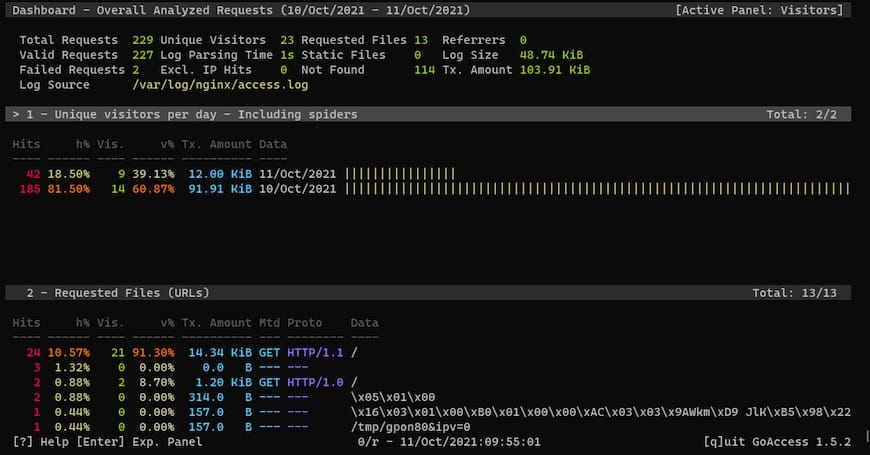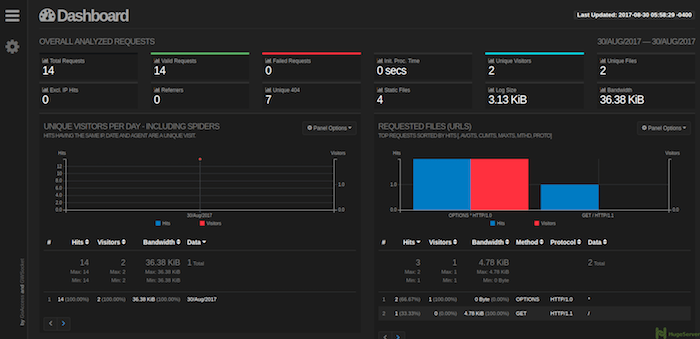
In this tutorial, we will show you how to install GoAccess on AlmaLinux 8. For those of you who didn’t know, GoAccess is an interactive and real-time web server log analyzer program that quickly analyzes and views web server logs. It provides fast and valuable HTTP statistics for system administrators that require a visual server report on the fly. It parses the specified web log file and outputs the data to the terminal.
This article assumes you have at least basic knowledge of Linux, know how to use the shell, and most importantly, you host your site on your own VPS. The installation is quite simple and assumes you are running in the root account, if not you may need to add ‘sudo‘ to the commands to get root privileges. I will show you the step-by-step installation of the GoAccess real-time web server log analyzer and interactive viewer on AlmaLinux 8. You can follow the same instructions for CentOS and Rocky Linux.
Prerequisites
- A server running one of the following operating systems: AlmaLinux 8.
- It’s recommended that you use a fresh OS install to prevent any potential issues.
- A
non-root sudo useror access to theroot user. We recommend acting as anon-root sudo user, however, as you can harm your system if you’re not careful when acting as the root.
Install GoAccess on AlmaLinux 8
Step 1. First, let’s start by ensuring your system is up-to-date.
sudo dnf update sudo dnf install epel-release sudo dnf install ncurses-devel libmaxminddb-devel openssl-devel sudo dnf groupinstall 'Development Tools'
Step 2. Installing GoAccess on AlmaLinux 8.
Now we download the latest version of the GoAccess from the official page using wget command:
wget https://tar.goaccess.io/goaccess-1.5.2.tar.gz
After that you just need to decompress it:
tar -xzvf goaccess-1.5.2.tar.gz
Next, configure and install the package:
cd goaccess-1.5.2 autoreconf -fi sudo ./configure --enable-utf8 --enable-geoip=mmdb --with-openssl sudo make sudo make install
Verify GoAccess installation:
goaccess --version
Step 3. Configure GoAccess.
By default, GoAccess stores its configuration file at /usr/local/etc/goaccess/goaccess.conf. Now we edit the configuration using nano text editor:
sudo nano /usr/local/etc/goaccess/goaccess.conf
Modify the following file:
# The following time format works with any of the # Apache/NGINX's log formats below. # time-format %H:%M:%S
# The following date format works with any of the # Apache/NGINX's log formats below. # date-format %d/%b/%Y # log-format COMBINED # log-format %v:%^ %h %^[%d:%t %^] "%r" %s %b "%R" "%u"
Save and close a file. After completing the configuration, now run GoAccess using the following command below:
sudo ln -s /usr/local/bin/goaccess /usr/bin/goaccess sudo goaccess /var/log/nginx/access.log
You will be greeted with the following dashboard:

Step 4. Generate HTML Report.
To generate an HTML report of your Nginx web server logs, just run it against your weblog file:
goaccess /var/log/nginx/access.log -o stats.html

Congratulations! You have successfully installed GoAccess. Thanks for using this tutorial for installing the GoAccess web log analyzer on your AlmaLinux 8 system. For additional help or useful information, we recommend you check the official GoAccess website.